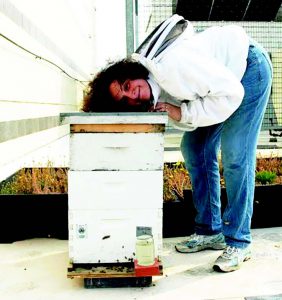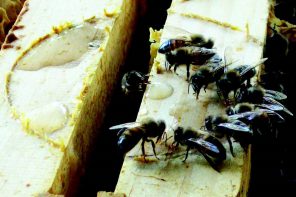By: Toni Burnham
Bee Sting Allergy Basics And Allergy Understanding For Beekeepers

It probably happens every time you talk to a group of people about beekeeping, whether it’s family or friends, a garden club, a fair, or a lecture situation. A larger-than-possible proportion of those present tell you that they have a bee sting allergy, and some may tell you that they fear for their lives. You might be dubious, and you might roll your eyes when discussing it with other beekeepers, but are you going to tell a scared person that you don’t believe them, or respect them as a human being who enjoys breathing? If nothing else, that’s not a caring place to come from, or a great boost to beekeeping in the community.
What do you say to folks who claim a bee sting allergy? Remember, they are afraid of something pretty important, and you are not a doctor (well, most of you aren’t). What do you actually know? And have you ever wondered about any danger to yourself or your family and neighbors, or made a plan just in case?
As an urban beekeeper in particular, honey bee sting allergy and the widespread fear of it seems like a potential risk to our neighbors that I need to know about, and something that beekeepers need to understand for themselves. We live in a world that is increasingly aware of and afraid of allergy, where people perceive allergy to be pervasive and increasing, and connected across all manner of health issues.
Is this true for us, as beekeepers? Is it something we should think twice about when placing honey bee colonies in urban or suburban locations? Three of my good beekeeper friends have received honey bee sting allergy diagnoses, and though I am sociable, I am not popular enough to have 3,000 close friends. It seems like more positive allergy tests than I would have expected! Allergy probably affects more than the one in a thousand I originally believed, but no connection of mine has experienced anaphylaxis (the life-threatening level of allergic reaction), either.
Dr. David B.K. Golden, literally the world authority on insect sting allergy, spoke with me (and is interested in learning from you, too) about bee sting allergy. This article hopes to help you understand and manage allergies to insect stings in a personal and practical way, and to be a good source of guidance to others. Just because I talked to a doctor, however, does not make this medical advice, and you really, truly need to see a trained allergist (allergist!) to help you work out your risk and possible treatment options if you are concerned.
You need some good news up front! Your chances, as well as those of your neighbors, of dying from a honey bee sting are somewhere between those of winning the lottery and getting struck by lightning. Don’t get cocky: both those things happen, but you have the ability to reduce the chance that it will happen to you. And not-as-bad things can happen more often.
Before we continue, I need to ask you to memorize the following:
Allergy is, by definition, a mistake your immune system makes when it treats something essentially harmless as a threat. Allergists are working to try to stop that. That solution’s a way off, though;
Having a positive allergy test/allergy in your system is not the same as being at high risk of a dangerous reaction;
There are multiple kinds of reactions: large local reactions which are not systemic, systemic reactions which are not dangerous, and anaphylactic reactions which can take your life. There’s more later about the differences and triggers for getting help.
That last scary part was included and put in bold type on purpose. With bee sting allergy, folks often seem to veer between hysterical fear and complete complacency. Beekeepers seem to be vulnerable to the latter. Neither position is responsible or safe for you or the civilians around you (who are more likely to be among the terrified).
Allergy risk/understanding the numbers
Guess what? There is no fixed number for “who has a bee sting allergy” in the general public. It varies in different countries and at different times, linked to exposure. Beekeepers have more exposure, of course. According to Dr. Golden, “In testing the general public, allergists have found that about 20% of the public will have a positive allergy test, but only 2-3% said that they had had a systemic reaction in the past.” Many of those folks who tell you that they are allergic had reactions that were not severe, and some may have had an allergy test…but if they never had an allergic reaction to a sting, that positive test still means that only about one in 10 of them is likely to have an allergic reaction of any kind, let alone a life threatening one.
“Those people who had a positive test (with no previous allergic reaction)? The allergy usually disappeared by itself in a few years, but, when it stayed positive and they got stung, there was at least an 85%-90% chance that they were not going to have a reaction and even less chance it would be severe! But some of them did. It’s therefore possible for you to have been stung but never had a reaction, and still have a positive test.”
Being stung sets the stage for a positive allergy test, though it doesn’t substantially increase the odds of a future dangerous reaction. Dr. Golden explains, “Beekeepers absolutely will have a higher frequency of positive tests. That is NOT the same as being allergic.”
Dr. Golden emphasizes that such testing should follow a possible allergic event, not be sought out ahead of time. “You may have been stung but never had a reaction, but you could nonetheless still have a positive test…though that test should never happen. Nobody should ever be tested if they have never had a bad reaction.”
“In all allergies (it’s not unique to insect venom) we don’t know why most people who have the allergy in their system don’t react. Lots of people have a positive test for cats or peanuts, but they have no reaction. That is the same for venom, if not more so – if we know someone has been stung recently, like in the past two to three months (or if they are beekeepers in season) the test can be positive in up to 40%!”
“That’s a lot of people with the allergy in their system, but they have no history of having a systemic reaction to a sting. In this case, they can have a positive test, but have only a 5% to 15% chance going forward of having a systemic reaction.”
This needs to be said, however: those with a positive allergy test face a greater risk than those who test negative for bee venom allergy. Dr. Golden adds this: “You know, even if the skin and blood tests should show negative in someone who had a severe reaction, the risk is very small but is still not zero because the tests are not perfect.”
Common Sense Allergy Care
Because more than 85% of people who have never had an allergic reaction to a sting but have a positive allergy test will never have a systemic reaction to future stings, these folks may make medically unnecessary or even unproductive decisions. People who have had an allergic reaction may not have figured out its cause, as well, and may blame the wrong culprit. Human beings, and apparently beekeepers in particular, often take not-well-understood allergy information and run to unhelpful places with it. That might take the form of living with an exaggerated sense of risk, or an unwise sense of invulnerability. The truth is almost always somewhere in the middle.
For instance, did you know that beekeepers frequently operate under a kind of self-immunization if they receive 50-100 bee stings over a year? That’s four to eight stings a month, or more likely a sting or two each week during the season in most places. If you (or your family members!) ever noticed that the first sting of the year, after a long winter, is noticeably more uncomfortable, and that later stings are easier to take, you might be experiencing self-immunization. However, the immunity you gain from stings during the season wears off during the sting-free winter. But if any sting starts closing your throat or makes you very light-headed, let an allergist do the immunizing. And don’t wait. Dr. Golden says that we beekeepers often do.
What if you are having a dangerous reaction to a sting? What should you do? Yes, seek medical help for immediate treatment, but get to the best information as quickly as you possibly can after you have been to the emergency room. In one simply terrifying study of allergy advice in U.S. emergency rooms (Evaluating the management of anaphylaxis in US emergency departments: Guidelines vs. practice, https://www.ncbi.nlm.nih.gov/pmc/articles/PMC4129832/) fewer than 9% of ERs used current guidelines for diagnosing, treating, and follow up care for allergy and anaphylaxis. Please note: these are cases when people showed up at risk of death from allergy, and fewer than 50% were referred to an allergist or given a prescription for an EpiPen (or equivalent).
ER patients rarely receive reliable information on the source of their reactions, as well. According to Dr. Golden, “People will go to the ER with hives or an allergic reaction, and the doctor will ask, ‘What did you eat?’ The patient says, ‘I don’t know, three days ago I ate shrimp,’ ‘Oh that’s it, it was the shrimp! You can’t eat shrimp anymore, or you will die.’”
“Twenty years later they come to me and say, ‘I haven’t eaten shrimp in 20 years,’ and I say, ‘Well, that probably wasn’t the cause of your reaction.’”
“Every severe allergic reaction should be evaluated by an allergist and should be tested to confirm one way or the other. I don’t care whether it is food or a drug or bee stings: if it is that bad, it needs to be correctly identified.” Because remember, in this example a person had an uncomfortable or even dangerous reaction to something, no one helped them avoid that health risk in future, and they went forward believing that they were safe. Bad medicine. In the case of insect stings, too many people who have bad reactions say “I have had so many stings in my life with no reaction, so this must have been a fluke and will never happen again .”
At this point, all those frightened folks at your bee event might kind of make sense. A lot of them have been told that they are allergic, very few by a trained allergist capable of helping them evaluate what happened to them and their future risk. As beekeepers who understand this better, we might be in a position to help them out.
What are these reactions, anyway?
Most beekeepers are generally familiar with the distinctions between local and systemic allergic reactions. But let’s go there, anyway.
Dr. Golden explains, “A large local reaction is where you get stung on your hand and the next morning you are swollen up to your shoulder. A huge swelling is a large local reaction, but it is not a systemic reaction.”
“A large local reaction we can arbitrarily define as being six to eight inches in diameter or larger (that’s pretty big), usually growing over 24 to 48 hours and taking five to 10 days to resolve. The big ones can be a whole arm or leg, and if it is on the head and neck it can be potentially threatening. But it doesn’t build up fast, it builds up slowly.”
“If you have had a large local reaction, and you are worried about a future sting causing anaphylaxis, I am going to tell you that you have a less than 3% chance. I am not going to recommend that you have tests, I am not going to recommend that you have shots, and I am even going to discuss with you whether it is worth getting an EpiPen (or similar) injector.”
The other type of allergic reaction is systemic: it appears elsewhere in the body, not just at the sting site. Typically, a systemic reaction creates fear and concern that a potentially life-threatening allergy is present. Any kind of systemic reaction warrants a consultation with an allergist, but they don’t all lead to Venom Immunotherapy (VIT), those injections of bee venom meant to immunize your system against the effects of bee venom.
There are different kinds of systemic reactions and they provoke different levels of concern. “The presence of hives and swelling on the outside of the body is not dangerous, though it is a systemic reaction… You could be covered in hives, but if there is no tongue or throat swelling, no breathing problem or nothing else, that’s a systemic reaction, not anaphylaxis, even though it might seem pretty scary. How would I treat that? Actually, pretty much the same as a large local reaction.”
“A large local reaction is caused by allergic antibodies, but those people usually don’t get a systemic reaction to a future sting. Their risk of getting a systemic reaction is about 7%, less than half of which (3%) would be severe enough to use an EpiPen.”
“Anaphylactic reactions are systemic reactions that come on in minutes, 10-30 minutes after a sting, and typically can cause hives or swelling on the outside of the body, but also cause internal symptoms like swelling of the throat or trouble breathing or anaphylactic shock – meaning low blood pressure, dizziness, unconsciousness.”
Hives are not always present in anaphylaxis! “If you get stung and you pass out and you don’t have hives, some folks say, ‘Oh that wasn’t an allergic reaction because you don’t have hives.’ That would be a bad mistake.”
But get this: “Of those with large local reactions, less than 3% will ever have an anaphylactic reaction to a sting. And that ‘less than 3%’ number is only slightly higher than the risk in ‘the general population.’”
Therefore, having a large local reaction, while uncomfortable, is not predictive of a future anaphylactic reaction…and not having hives does not mean that you did not experience a multi-system, potentially anaphylactic reaction.
I know, this is hard, right?
Risk to the public?
Over the past few years, it appears that discussion and diagnosis of a wide range of allergies is increasingly common, and that raises fears of bee sting allergy in particular. Dr. Golden has participated in cases where these fears played a role in attempts to ban beekeeping.
“This actually comes up quite a bit in home owners associations and county councils, for example. In these cases, someone gets upset because they believe they are going to die, or their kid is going to die because their neighbor has a beehive.”
“A township in Pennsylvania was on the verge of taking some very strong action and I was asked to comment by a reporter,” and he found that the health and safety concerns raised by worried neighbors had no grounding in the facts.
“Realistically, if my neighbor has a beehive, what are the chances that they are going to get stung? Well, if they are tending their own hives, there is a very good chance that the beekeeper will be stung. What is the chance that I will get stung by my neighbor’s bees? Actually, just a tiny bit higher than average (because I am closer to foragers). But a more significant risk may be that the beekeeper’s neighbors are so afraid, that their actions could be agitating the bees…and there is most probably a negligible increased risk to anyone in the vicinity outside of, say, 50-100 yards.”
“In the earlier case, one of the issues brought up was, ‘My child is very allergic, and has allergies to so many things. If they get stung by a bee, I’m afraid that they will die!’
And I said, ‘Well, just a minute.’”
“Insect sting allergy is not correlated with other allergies. You can have all sorts of allergies to cats and foods and a range of other things, and that does not mean that you are going to be allergic to stings.” “Another issue in that case was, ‘My child has a weakened immune system, (an immunodeficiency) and therefore they will die if they get stung.’ There again, insect sting anaphylaxis has nothing to do with immune deficiency. A weakened immune system is not necessarily more susceptible to allergies. You are either allergic or you are not.”
“The rate of insect sting allergy also seems pretty stable. Pretty much every other allergy problem seems to be increasing at an alarming rate, but insect sting allergy does not seem to be.”
“Yet we have found on the other hand that we have a very poor handle on that. That’s because it is kind of an invisible allergy. We estimate that only one out of every ten people with an insect sting allergy ever gets to an allergist. Most of them don’t even tell their doctor.”
“What we are more used to seeing is a person who has two or three or four reactions, then their family member drags them to a doctor’s office. They say ‘Well, I’ve been stung many times in my life with no problem, so I figured it was nothing. So what if I nearly died? I thought it could never happen again.’ For some reason, if you had an itchy arm after eating a peanut, you would go to a doctor. But after a bee sting reaction, you don’t. That’s where we are at these days.”
Are beekeepers at risk?
Developing an allergy to insect stings is related to exposure, and beekeepers certainly have that. If 3% of the general public reports a systemic allergic reaction to an insect sting at some time in their lives, it is likely that beekeepers will report a considerably higher number of reactors.
Some beekeepers obviously do become allergic and it is really not appropriate for them to try self-immunizing in the way mentioned earlier. Dr. Golden explains, “One of the problems with beekeepers attempting to self-immunize is that you have to build up your immunity incrementally in the beginning. You can’t do that with self-stinging without possibly having a bad reaction.” Also, they would have to continue to get regular stings through the winter to maintain the immunity and avoid a severe reaction to the first stings in the spring.
We mentioned earlier that there are large local, systemic-but-not-life-threatening, and anaphylactic reactions to bee stings. As a beekeeper (or member of a beekeeping family) who likely gets stung regularly, you might be wondering how to judge the symptoms you encounter and changes over time that you might observe. According to Dr. Golden, “If you have a large local reaction, you are still having an allergic reaction, but the likelihood of having a systemic reaction is still only in the 7% range. Many of those will not be anaphylactic. The likelihood of a reaction that requires treatment with epinephrine is less than 3% for those with large local reactions. It is also less than 3% for those with the so-called milder (non-anaphylactic) systemic reaction.”
“It’s when you get even the slightest reaction that affects tongue or throat or breathing, or causes light-headedness, however, that you have a sign that a future sting could be severe.”
And take yourself to an allergist if that happens. If you experience tongue swelling, dizziness, or trouble breathing, you are deeply in the danger zone. In that situation, “The risk jumps by ten times, meaning that there is a 30-70% likelihood of a life-threatening reaction to a future sting.”
“Sometimes the allergist and the patient have to have a discussion to decide whether it is worth being immunized if the reaction wasn’t that bad. Certainly, with any degree of tongue or throat swelling or with any of those other reactions, it is advised.”
“From my point of view, the treatment is so easy, safe and effective that it is crazy to take chances. So, it is easy for the beekeeper to get immunized and take the risk down to essentially zero.”
But Dr. Golden does not pull punches on beekeeper allergies. “If someone needs to be on venom immunotherapy (VIT), they need to be on the full dose. In fact, with beekeepers I usually do a double dose. If an allergist is not able or willing to treat the patient up to the highest dose, they are not doing that patient any favors. They may actually be making an allergy stronger.”
Dr. Golden offers, however, “If you look at 1,000 beekeepers (we don’t have a number for sure) I would still expect to see only 4-5 times the likelihood of a systemic reaction: that still puts us only in the 8-10% range. Based on experience, I would estimate that about 5-10% of beekeepers will experience a systemic reaction.” He would prefer not to estimate, though.
Going forward with better information
I’ve met too many beekeepers who experienced allergic reactions to stings to be able to ignore that there could be a risk to my family, my community and my neighbors, but (like beekeeping) the only way to make a safe assessment and good decisions is with clear and reliable information that you gather in advance. Dr. Golden has laid out a helpful map of risks, responses, and tools we can use to take care of ourselves and those near us.
Dr. Jamie Ellis of the University of Florida also wrote an extremely helpful article that reviews additional information about bee sting allergy in the January 2016 issue of The American Bee Journal, and I highly recommend that all beekeepers review it, as well.
As a beekeeper, you could have a 10-times-higher likelihood of experiencing an allergic reaction than the general North American public, but that still puts you in a fractional minority. Your risk can change over time, though, so it is worth familiarizing yourself with bee sting allergy, and perhaps taking measures ahead of time – like requesting a referral to an allergist if you are becoming concerned about your reactions, or asking for a prescription for an epinephrine injector and getting training in its use. But remember insect sting allergies are not on the rise, or linked to other allergies or immune disorders, and we can rely on that information to calm fears. If people around you are not receiving good information from a trained allergist, encourage them to seek one out and learn more about their own well-being, and how our bees are a healthy part of it.
Toni Burnham keeps bees and does her best to educate the public in Washington, DC.









